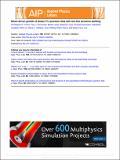Files in this item
Strain-driven growth of GaAs(111) quantum dots with low fine structure splitting
Item metadata
| dc.contributor.author | Yerino, C.D. | |
| dc.contributor.author | Simmonds, P.J. | |
| dc.contributor.author | Liang, B. | |
| dc.contributor.author | Jung, D. | |
| dc.contributor.author | Schneider, C. | |
| dc.contributor.author | Unsleber, S. | |
| dc.contributor.author | Vo, M. | |
| dc.contributor.author | Huffaker, D.L. | |
| dc.contributor.author | Höfling, S. | |
| dc.contributor.author | Kamp, M. | |
| dc.contributor.author | Lee, M.L. | |
| dc.date.accessioned | 2015-01-14T16:01:03Z | |
| dc.date.available | 2015-01-14T16:01:03Z | |
| dc.date.issued | 2014-12-22 | |
| dc.identifier | 161868497 | |
| dc.identifier | 3cab0ce1-97a8-4cd1-b99e-41c655990d41 | |
| dc.identifier | 84919798208 | |
| dc.identifier | 000346914000008 | |
| dc.identifier.citation | Yerino , C D , Simmonds , P J , Liang , B , Jung , D , Schneider , C , Unsleber , S , Vo , M , Huffaker , D L , Höfling , S , Kamp , M & Lee , M L 2014 , ' Strain-driven growth of GaAs(111) quantum dots with low fine structure splitting ' , Applied Physics Letters , vol. 105 , no. 25 . https://doi.org/10.1063/1.4904944 | en |
| dc.identifier.issn | 0003-6951 | |
| dc.identifier.uri | https://hdl.handle.net/10023/5997 | |
| dc.description | C.D.Y. acknowledges support from the Department of Energy Office of Science Graduate Fellowship Program (DOE SCGF), made possible in part by the American Recovery and Reinvestment Act of 2009, administered by ORISE-ORAU under Contract No. DE-AC05-06OR23100. Additional support was provided by the University of California Lab Fees Research Program (Grant No. 12-LR-238568). | en |
| dc.description.abstract | Symmetric quantum dots (QDs) on (111)-oriented surfaces are promising candidates for generating polarization-entangled photons due to their low excitonic fine structure splitting (FSS). However, (111) QDs are difficult to grow. The conventional use of compressive strain to drive QD self-assembly fails to form 3D nanostructures on (111) surfaces. Instead, we demonstrate that (111) QDs self-assemble under tensile strain by growing GaAs QDs on an InP(111)A substrate. Tensile GaAs self-assembly produces a low density of QDs with a symmetric triangular morphology. Coherent, tensile QDs are observed without dislocations, and the QDs luminescence at room temperature. Single QD measurements reveal low FSS with a median value of 7.6 μeV, due to the high symmetry of the (111) QDs. Tensile self-assembly thus offers a simple route to symmetric (111) QDs for entangled photon emitters. | |
| dc.format.extent | 1301940 | |
| dc.language.iso | eng | |
| dc.relation.ispartof | Applied Physics Letters | en |
| dc.subject | QC Physics | en |
| dc.subject.lcc | QC | en |
| dc.title | Strain-driven growth of GaAs(111) quantum dots with low fine structure splitting | en |
| dc.type | Journal article | en |
| dc.contributor.institution | University of St Andrews. School of Physics and Astronomy | en |
| dc.contributor.institution | University of St Andrews. Condensed Matter Physics | en |
| dc.identifier.doi | https://doi.org/10.1063/1.4904944 | |
| dc.description.status | Peer reviewed | en |
This item appears in the following Collection(s)
Items in the St Andrews Research Repository are protected by copyright, with all rights reserved, unless otherwise indicated.

